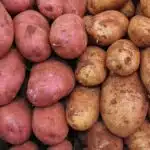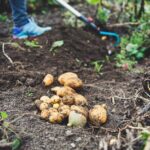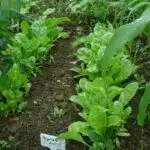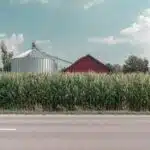Potatoes have long been a staple of the dinner table, providing a nourishing and filling meal for people around the world. But did you know that growing potatoes in containers is easier than ever? With just a few simple steps, you can unlock the secret to harvesting your own delicious potatoes right at home. Let’s dig in and explore how to grow potatoes in containers!
Every gardener knows that having their own fresh produce is one of life’s great pleasures. Now, with the advent of container gardening, even those with limited space can enjoy homegrown vegetables. Potatoes are an especially good choice for container gardening – they are amazingly resilient and can thrive even when not planted in the ground.
Container gardens provide a unique opportunity for gardeners to experiment with different varieties of potato, as each type has its own flavors and textures to offer. In addition, growing potatoes in containers allows gardeners to harvest them quickly and easily without having to dig deep into soil or worry about pests or diseases affecting their crop.
Whether you want to enjoy freshly harvested potatoes year-round or just during the summer months, this guide will show you everything you need to know about growing potatoes in containers. With just a few simple steps, you can become an expert potato grower and reap the rewards of your hard work!
Selecting The Right Potatoes
Choosing the right potatoes for container gardening is an important step in the process of growing potatoes. A wide variety of spuds can be grown in containers, but some do better than others. If you’re looking to get started with potato gardening, it’s best to select a variety that is well suited to a container environment.
Some good options include Yukon Gold, Red Pontiac, and Russian Banana Fingerling varieties. These types are all well-suited to growing potatoes in containers because they are relatively low maintenance and require minimal space. They also tend to produce good yields without taking up too much room.
It’s also important to note that when selecting the right potatoes for your container garden, you should look for varieties that have been certified as organic or are labeled as disease resistant. This will help ensure that your potato crop is healthy and productive throughout the season. In addition, you should always buy seed potatoes from a reputable source to ensure quality and freshness. With the right selection of potatoes and proper care, you will have an abundant harvest!
Preparing The Pot
Growing potatoes in a container is like taking a gamble—you never know what your yield will be. But with a few simple tricks, you can stack the odds in your favor. The second step in growing potatoes successfully is preparing the pot.
When selecting a pot for planting potatoes, it is important to choose one with drainage holes so that excess water can escape and the soil remains loose. A twenty-inch pot should work for one or two plants; for three or more plants, an even larger container would be beneficial. Once you have chosen your pot, fill it with quality soil to provide nutrients to the growing potatoes.
Next, make sure you give the potatoes room to grow by placing them five to six inches apart from each other. If you are using seed potatoes, cut them into two-inch sections and ensure that each section has at least two eyes before planting them in the soil. Covering the seed potatoes with about four inches of soil will help protect them from any pests or disease that may be present in the environment.
As soon as your potatoes are planted and covered, they just need regular watering and attention to provide you with a bountiful harvest!
Planting And Covering The Potatoes
Many are hesitant to try growing potatoes in containers, as they think it is too tricky and time-consuming. However, planting and covering potatoes in a container is actually quite easy! It’s just a matter of digging the right-sized hole, adding some soil mix, and covering it up with straw or soil. Here’s how you can do it:
Digging the Hole: Before you plant your potatoes, dig a hole that is about 4 inches wide and 8 inches deep. Make sure to space the holes about 12 inches apart for optimal growth.
Adding Soil Mix: Next, fill the hole with a good quality soil mix that drains well. If you’re using store-bought bags of soil mix, make sure it contains plenty of compost or aged manure as this will help ensure your potatoes have all the nutrients they need to grow.
Covering With Straw or Soil: Finally, cover your potatoes with either straw or soil and water them until they are moist but not soggy. The straw will help retain moisture while also keeping weeds away from your potatoes while the soil helps protect them from extreme temperatures and other weather conditions like frost.
These three steps will get your potato crop on its way to success! Now all you need to do is keep an eye on watering and fertilizing levels so that your potatoes can reach their full potential!
Watering And Fertilizing
Watering and fertilizing potatoes grown in containers is like the lifeblood of a healthy crop. It’s like sending a steady stream to your plants, ensuring they have all the necessary nutrients for robust growth. It’s not hard to do, but it does require attention and thought.
Like any good gardener knows, proper watering is essential for potato growth. Potatoes need at least an inch of water each week, either from rainfall or from watering by hand. To ensure that the soil around your potatoes stays moist, use a soaker hose or drip irrigation system. When you water by hand, make sure that you saturate the soil evenly and avoid wetting the leaves and stems if possible.
During mid-season fertilization is also important to promote vigorous growth in your potatoes. Use a balanced fertilizer such as 10-10-10 or 5-10-5 at planting time and then again when flowering begins. This will help provide the right nutrients for larger yields of potatoes over time.
By following these guidelines on watering and fertilizing your container grown potatoes, you can ensure that they flourish and produce a bountiful harvest! With just a little bit of effort and care you can have tasty potatoes straight from your own backyard!
Maintaining The Plant
Maintaining the plant is a critical step in ensuring that your potatoes have a successful harvest. And while it may sound like a daunting task, with the right approach, you can easily manage your potato plants and get delicious potatoes in return. Here are three tips to help you maintain your potato plants:
Keep an eye out for pests or diseases: A healthy garden requires regular monitoring and vigilance against pests or disease. Check your potato plants daily and take action if needed.
Provide adequate sunlight: Potatoes need plenty of sunlight to thrive, so make sure they get plenty of it by positioning them in an area that gets at least six hours of direct sunlight per day.
Prune regularly: Regular pruning helps ensure that your potato plants won’t become overgrown and will remain healthy throughout the growing season. Pruning also helps increase yields by promoting more shoots and larger potatoes!
With these simple tips, you’ll be well on your way to having bumper crops of delicious homegrown potatoes! It’s important to remember that when it comes to planting potatoes in containers, patience is key – but with proper maintenance and care, your efforts will pay off with tasty rewards!
Harvesting
Harvesting potatoes from your container is easy and rewarding. When the plants have flowered, you can begin to harvest. The best way to do this is to carefully dig around the plant with a shovel or trowel. You should be careful not to damage any of the potatoes as they are tender and may be easily bruised. Make sure you look for potatoes of all sizes, since smaller ones will grow bigger if left in the soil longer.
The next step is to remove all the potatoes from the soil and place them in a basket or tray and bring them indoors. Once inside, it’s important that they dry before storing them long-term. This can take anywhere from one to three weeks, depending on conditions such as temperature and humidity.
When your potatoes are fully dried, you can store them in a cool, dark place for up to six months – maybe even longer! With proper care and maintenance, you’ll be able to enjoy homegrown potatoes for an extended period of time. Now that you know how to harvest your potatoes, let’s look at some tips for growing potatoes in containers!
Tips For Growing Potatoes In Containers
Who would have thought that growing potatoes in containers could be so easy? The task that was once considered a herculean one, can now be done with much ease. Believe it or not, with the right set of tips and tricks, you could have potato plants flourishing in no time. In this article, we will discuss the ‘Tips for Growing Potatoes in Containers’, so that you can reap the benefits of growing potatoes without any hassle.
The first tip is to choose the right type of container for your potatoes. You want something large enough to allow several tubers to grow and spread out. It’s also important to make sure your container has good drainage capabilities. After selecting the right container for your potatoes, fill it up with good quality potting soil and make sure it is adequately moistened before planting your potatoes.
When planting your potatoes, make sure they are planted at least four inches deep in the soil. For best results, plant multiple seeds around each potato cut into sections as this will help ensure a larger harvest later on. Additionally, you should consider adding some organic fertilizers into the mix as this will help give them a nutrient boost and increase their yield. Finally, be sure to water your plants regularly and mulch heavily when needed as this will help keep them healthy and strong throughout their growth cycle!
With these simple tips in mind, there’s no doubt you’ll have success growing delicious potatoes in containers! Not only will you get a tasty treat at harvest time but you’ll also enjoy all the other benefits that come from producing your own food – from promoting sustainability to improving nutrition!
Benefits Of Growing Potatoes In Containers
Pleasingly, planting potatoes in containers presents plentiful perks. People pursuing the potato-growing path can reap the rewards of this fantastic, fruitful farming. Here are eight benefits of growing potatoes in containers for those wanting to wander into this worthwhile world.
Firstly, container potatoes require far less space than tilling a traditional garden plot. This makes them ideal for small spaces such as balconies and patios. With thoughtful tending, they can even be grown indoors on shelves or in hanging baskets! Secondly, it’s easier to keep track of your spuds when they’re confined in one area. You won’t have to worry about searching an entire garden bed for forgotten tubers.
Thirdly, containers offer superb soil quality control. When you mix your own potting soil blend, you can ensure that their roots get all the nutrients they need while avoiding soil-borne pests and diseases. Fourthly, containers make it simple to practice crop rotation from season to season – just move them around if needed! Fifthly, you don’t have to worry about digging up or tilling the soil every year; simply remove the old soil and replace with fresh compost instead.
You’ll also save time on weeding since you can use organic mulch like straw or newspaper to suppress weeds and retain moisture within the container itself. Finally, harvesting is a breeze thanks to easy accessibility – no more bending over or crouching down! Plus, there’s nothing quite like seeing your hard work pay off as you unearth plump tubers with delight!
Common Mistakes To Avoid
Growing potatoes in containers can be a great way to enjoy homegrown spuds without the need for a large garden. For example, one couple in Minnesota was able to produce over 100 pounds of potatoes from their 5-gallon buckets. But even with all the benefits, there are still some common mistakes to avoid when growing potatoes in containers.
First, it is important that you don’t plant too many potato seeds in one container. Overcrowding will cause the plants to compete for nutrients and could result in stunted growth or disease. Additionally, make sure that your containers have good drainage and that they get enough sun throughout the day. Containers with poor drainage will cause root rot, while those without enough sunlight won’t produce as many potatoes as possible.
Finally, it is important to choose varieties of potato seeds carefully. Some varieties may not do well in certain climates or soil types and could end up being a wasted effort if they fail to produce a decent crop. Always research which potato variety is best suited for your area before planting them in a container.
By learning these common mistakes and following the tips above, you can avoid potential problems when growing potatoes in containers and enjoy a successful harvest each year! With this knowledge under your belt, you are now ready to learn about troubleshooting tips for any issues that might arise during the growing process.
Troubleshooting Tips
Hit the nail on the head with this one: troubleshooting your potato-growing attempts is a must. This tenth step in growing potatoes in containers touches on some common issues and how to address them.
The first thing to remember is that potatoes require soil with good drainage, so if you’re having problems, make sure not to over-water them. If you’re using a plastic container, make sure it has plenty of holes for water to escape through.
Additionally, if your potatoes are experiencing pest or disease problems, keep an eye out for signs of rotting or wilting leaves and dispose of any affected plants immediately. If you spot any signs of pests such as aphids or slugs, use organic bug sprays to kill them off while being mindful not to harm the environment. Finally, don’t forget about fertilizing regularly so that your potatoes have enough nutrients to thrive!
With these tips in mind, you should be well on your way to success in your potato-growing efforts! Taking the time to troubleshoot potential issues will help ensure your plants stay healthy and productive by providing the best possible growing conditions. With careful attention and preparation, you can reap a bountiful harvest from those spuds!
Companion Planting For Potatoes
Companion planting for potatoes is an important part of successful potato growth. As with any type of gardening, understanding what plants work best together can help maximize the yield and size of your potatoes. It’s also beneficial to know which plants can help repel pests, enrich the soil, and provide additional nutrients.
In companion planting for potatoes, it’s important to remember that certain plants don’t always get along. For example, tomatoes and potatoes should not be planted near each other as they are both prone to a similar type of blight. However, there are many other plants that make great companions for potatoes such as beans, carrots, and onions. These vegetables will provide extra nitrogen to the soil and help keep insect pests away from your potatoes. Additionally, you may want to consider adding cover crops like clover or rye grass for extra protection against weeds and pests.
By taking advantage of companion planting for potatoes in containers, you can ensure a bumper crop of delicious spuds! This technique will provide your plants with the nutrients they need while keeping unwanted visitors away from your precious taters. Plus, it’s an environmentally friendly way to boost the health of your soil without using harmful chemicals or fertilizers. With a little bit of planning and careful selection of companion plants, you’ll soon be enjoying tasty homegrown potatoes!
Storing And Replanting Potatoes
Storing and replanting potatoes is like a chess game – it requires strategic planning and thoughtful execution. To store potatoes, the tubers must be harvested at the right time so that they are mature but not overly ripe. After harvesting, the potatoes should be kept in a cool, dark place to prevent sprouting. Replanting potatoes is a bit of an art form. It involves selecting seed potatoes from those that have been stored, cutting them into pieces that contain at least two eyes each, and then planting them in soil with adequate drainage. Careful consideration should be taken when planting to make sure the cut surface faces up and receives sunlight while the rest of the potato is covered in soil.
Once planted, potatoes will require regular watering and weeding to ensure robust growth. Mulching around plants can help conserve moisture as well as discourage weeds from taking root. To maximize yields, gardeners can use fertilizers or organic matter to provide nutrients for their potato plants throughout the growing season.
With careful attention and diligent care, storing and replanting potatoes will give gardeners access to an abundant supply of homegrown spuds year-round! By following these steps, growers can easily have success with this staple crop regardless of size or space constraints. Now that we have covered storing and replanting potatoes, let’s move on to pest and disease control for these versatile vegetables.
Pest And Disease Control
Pests and disease control is an important part of growing potatoes in containers. The plants can be affected by a variety of pests, including aphids, potato beetles, and slugs. They can also suffer from various diseases like bacterial wilt and late blight. To help protect your plants, it’s important to use preventative measures and treatment methods.
Preventative measures include: • Inspecting the plants regularly for signs of damage or disease • Removing any weeds or debris near the container • Pruning off any dead or diseased stems or foliage • Applying a fertilizer specifically designed for potatoes • Watering at the base of the plant rather than overhead
Treatment methods may include: • Spraying with insecticide to eliminate pests such as aphids or potato beetles • Applying fungicides to treat fungal diseases like late blight • Rotating crops each season to reduce the chance of soil-borne diseases recurring in subsequent years. It’s also important to remember to clean up any debris after harvesting potatoes, so you don’t spread disease or pests when replanting. Taking these steps will help ensure your potatoes thrive in their containers.
To maximize success with pest and disease control, it’s essential to stay vigilant about inspecting your plants regularly. Keep an eye out for signs of trouble and take action as soon as possible if you find anything amiss. With proper care, you’ll have delicious homegrown potatoes in no time!
In Conclusion
Before wrapping up our discussion on growing potatoes in containers, let’s take a look at the big picture. After all the hard work, it’s time to sit back and admire your efforts! In conclusion, growing potatoes in containers can be a rewarding and successful endeavor.
First, you must choose which type of container to use. Then, you need to select healthy seed potatoes and prepare them for planting. After that, it’s essential to provide plenty of sun, water and fertilizer for optimal growth. Finally, pest and disease control is important for keeping your plants healthy.
All these tasks may seem intimidating at first, but with proper care and attention your potato plants should thrive! With the help of this article you now have the knowledge needed to get started on this exciting journey. So why not give it a try? You’re sure to be pleased with the results.
By following these steps we’ve discussed, you’ll be well on your way to reaping the rewards of growing potatoes in containers. Now let’s turn our focus towards the resources available for helping you succeed in this endeavor.
Resources For Growing Potatoes In Containers
Growing potatoes in containers is an achievable goal with the right resources! After all, who wouldn’t want to grow their own potatoes at home? We’ve already discussed the unique benefits of container gardening – no soil preparation and more control over your yield. But where can you find information to help you get started?
Fortunately, resources are available to make growing potatoes in containers much easier. From online guides and videos to books and magazines, you can find a wealth of knowledge about how to create the perfect potato patch. With these resources in hand, you can be sure that your potato plants will get off to a strong start.
Your local garden center or nursery can also provide helpful advice on cultivating potatoes in containers. They often carry special varieties developed for container gardening, as well as fertilizer and other supplies that will keep your plants thriving. If you’re looking for support from other potato growers, try joining an online forum or local horticultural society – there’s nothing like hearing from experienced growers who have been there before!
Now that you know where to find the resources you need, it’s time to roll up your sleeves and begin growing your own potatoes at home! With a bit of planning and patience, soon enough you’ll have delicious homegrown spuds ready for harvest.
Frequently Asked Questions
What Is The Best Type Of Soil For Growing Potatoes In Containers?
For the green-thumbed, eager to add potatoes to their container garden, there is a simple answer: soil. An integral part of any successful endeavor, soil helps to nurture and sustain the potato plants with its fertility and richness. It’s almost as if it’s the lifeblood of an aspiring potato farmer!
When it comes to growing potatoes in containers, soil plays a special role. Not just any dirt will do; rather, you need something that is nutrient-dense and capable of sustaining your plants through their entire growth cycle. A mix of organic matter such as well-rotted manure or compost combined with peat moss is ideal for this purpose. Additionally, you may want to add perlite or vermiculite to help maintain moisture levels in the soil.
The best way to ensure success when growing potatoes in containers is by taking the time to properly prepare your soil before planting. With just a bit of effort up front, you can ensure that your potato plants thrive throughout their growth process and deliver high yields come harvest time! So don’t be afraid – get out there and get growing!
How Often Should I Water My Potato Plants?
Growing potatoes in containers is an incredibly rewarding experience! With a bit of know-how and dedication, you can cultivate the most perfect potatoes of your life. The key to success? Knowing how often to water your potato plants.
When it comes to keeping your potatoes happy, there’s no such thing as too much care! In fact, watering your potato plants is one of the most important steps in the process. If you skimp on watering, you won’t reap the rewards of that delicious harvest. So when it comes to keeping your little spuds hydrated – more is definitely better!
The amount of water needed for optimum growth depends on factors like soil type and climate, but generally speaking you should aim for deep but not excessive watering several times a week. If possible, try to keep the soil moist at all times by using mulch or compost around the base of each plant. It doesn’t take much effort – just a few minutes every few days – and it’ll make a huge difference to your potato crop!
Is There Any Benefit To Planting Companion Plants With My Potatoes?
Have you ever wondered if there are any benefits to planting companion plants with your potatoes? Growing potatoes in containers can be a great way to make the most of limited space, but is it possible to get even more out of the experience? Could adding a few other plants make your potato crop bigger or better? Let’s explore the potential benefits that companion planting may bring.
When considering companion plants for your potato crop, look for those which will help with weed control and pest control. Planting onions near your potatoes, for example, is said to ward off aphids and other pests. Similarly, flowers like marigolds can be planted with potatoes to repel nematodes. These plants attract beneficial insects while deterring the bad ones – a double whammy! Additionally, planting taller crops such as corn or pole beans alongside your potatoes will provide some welcome shade during hot summer days and protect against wind damage.
Last but not least, companion planting can help maximize the nutrients available in the soil by introducing nitrogen-fixing plants that replenish nitrogen levels. This could give your potatoes an extra boost when it comes time to harvest! And who doesn’t want bigger and better potatoes from their container garden? So why not give it a try and see what kind of success you could have with companion planting? All it takes is a bit of experimentation, so get out there and give it a go!
What Are The Most Common Pests And Diseases That Could Affect My Potato Plants?
Gardening with potatoes can be a rewarding experience. But just like any other plant, they are vulnerable to pests and diseases. It’s important to know what to watch out for when growing potatoes in containers.
As you tend to your potato plants, keep an eye out for some of the most common pests and diseases. These include Colorado Potato Beetles, potato blight, and scab fungus. Colorado Potato Beetles feed on the leaves of potato plants, leaving them discolored and wilted. Potato blight is caused by a fungal disease that is spread through moisture in the air and soil, leading to rotting stems and leaves that eventually turn black. Lastly, scab fungus affects the skin of potatoes and causes them to become rough or discolored.
Fortunately, these problems can be prevented with proper care. Make sure your container has good drainage so the soil doesn’t stay soggy after watering. Keep weeds away from your potato plants as they can harbor pests and diseases. And make sure your container is deep enough so the roots have plenty of room to grow. With regular maintenance and vigilance, you’ll be able to keep your potato plants healthy and strong!
How Can I Tell When My Potatoes Are Ready To Be Harvested?
Harvesting potatoes is a highly rewarding process, offering gardeners the chance to enjoy their own homegrown crop! But when should you harvest your potatoes? With a little bit of knowledge, you can easily tell when your potatoes are ready to be dug up.
Did you know that on average, each potato plant yields around 6-10 potatoes? That’s a great return for such a small amount of effort. While the exact timing varies depending on the variety and climate, typically potatoes can be harvested anywhere between 8-12 weeks after planting. To tell if they’re ready, look out for the yellowing foliage and wait until the skin has hardened and turned a deep brown colour. Once this happens, it’s time to pull them out of the ground or container!
To ensure a good quality crop, check your plants regularly for signs of pests or disease. Harvest any affected plants immediately and discard them away from other vegetables. This will help prevent any further spread in your garden. With these simple tips in mind, enjoy harvesting your tasty home grown potatoes!
Conclusion
Potatoes in containers can be a great way to grow large, healthy potatoes without taking up too much space. With the right soil, adequate watering and pest control, you can have an abundant harvest of delicious potatoes. Just remember that potatoes take several months to mature and need to be harvested at the right time for optimal flavor and texture.
Growing potatoes in containers is a rewarding experience. Your hard work will be rewarded with tasty, nutritious potatoes that are sure to make your mouth water! Whether you’re growing them for yourself or giving them away as gifts, you’ll find that it was well worth the effort.
With just a little bit of effort, you can reap an unbelievably bountiful harvest of potatoes! It’s like opening a treasure chest full of deliciousness – your efforts will be rewarded with such an incredible abundance of fresh potatoes, it will seem like you hit the jackpot every time!





























